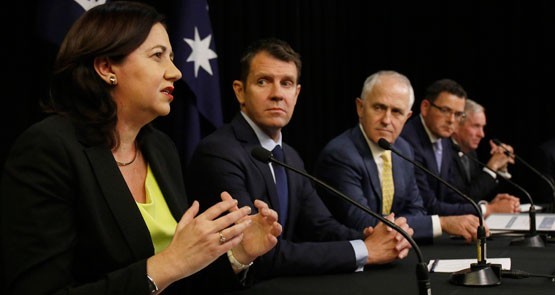
Last year’s intrigue in Canberra and contentious elections on a state level have given way to a wave of political contentment across Australia’s most populous states.
Newly released aggregate figures of Essential polling conducted between October to December last year shows that in New South Wales, Victoria, Queensland, South Australia and Western Australia, voters are, on a two-party preferred basis, content with their political rulers.
In New South Wales, Premier Mike Baird is riding high, having improved his polling even on the already impressive 54.3% of the vote the Liberals secured in the March 2015 election. The Liberals, according to Essential, now command a 56%-44% two-party preferred lead over the Labor opposition, a figure that has remained steady during all three months of polling aggregated by Essential.
South Australian voters are also very happy with their choices. Jay Weatherill leads a 14-year-old Labor government that has lost the two-party preferred vote the last two elections, nonetheless clinging onto power through highly targeted campaigning in marginal electorates. In South Australia’s last state election in March 2014, Labor secured only 47% of the state vote after preferences. But since then it’s clawed back ground, now leading the Liberals 54% to 46% on a two-party preferred basis, according to Essential.
In Victoria, Daniel “Dan” Andrews runs a government that’s grown in popularity since it swept to power in November 2014. Labor leads 53%-47% , an improvement on its 52%-48% result in the election.
In Western Australia, another long-standing government still trumps the opposition, even if only barely. Colin Barnett’s nearly eight-year-old Liberal government leads Labor 51%-49%. That’s a deterioration from the March 2013 election, when the Liberals secured 57.3% of the vote after preferences. An election in Western Australia is due March 2017.
The closest result is in Queensland, where the two-party result is a knife-edge 50%-50%. Annastacia Palaszczuk’s new Labor government has lost ground since the election, when it gathered 51.1% of the vote after preferences. In October and November, the two-party preferred polling had Labor with a 51-49% lead over the LNP, but this deteriorated sharply in December when the LNP rapidly gained ground (53%-47% to the LNP). The aggregate October-December figures thus have both parties even.
Essential’s first federal poll of the year is due next week, but other polling continues to show Prime Minister Malcolm Turnbull with a healthy lead over Opposition Leader Bill Shorten since toppling former leader Tony Abbott in September last year. Across the nation, it seems, voters are sticking with the devil they know.








Sounds like the bad, old advice once given to battered spouses.
Some voters might be content with their State leaders but it isn’t the case in the Hunter Valley north of Sydney. There’s half a million people here and most of them don’t want Baird, or the Sydney-centric Coal and CSG friendly government he leads.
The electoral system in this state is broken. All Baird has to do is throw government money at Western Sydney, to the detriment of the rest of the state, and he can regain government with the help of the Murdoch media. It stinks and no one cares.
The Hunter has a long History of being taken for granted by Labor, Zeke, which has scant to do with electoral systems.
What about Tasmania? We are a part of Australia too. Unlike the dills in the capital cities do not like our current devil.
You ask, “What about Tasmania?” bushby jane, so I wonder if you mean the special treatment that State has received ever since the Braddon clause.
Please explain.